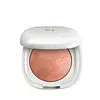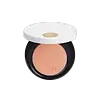What's inside
What's inside
 Key Ingredients
Key Ingredients

 Benefits
Benefits

 Concerns
Concerns

 Ingredients Side-by-side
Ingredients Side-by-side

Talc
AbrasiveMica
Cosmetic ColorantSynthetic Fluorphlogopite
Dimethicone
EmollientOctyldodecyl Stearoyl Stearate
EmollientNylon-12
Isopropyl Palmitate
EmollientPolysorbate 20
EmulsifyingParfum
MaskingMagnesium Aluminum Silicate
AbsorbentLauroyl Lysine
Skin ConditioningCaprylyl Glycol
EmollientSimmondsia Chinensis Seed Oil
EmollientTocopheryl Acetate
AntioxidantOlea Europaea Fruit Oil
MaskingHexylene Glycol
EmulsifyingTin Oxide
AbrasiveSorbitan Stearate
EmulsifyingAcrylamide/Sodium Acryloyldimethyltaurate Copolymer
Emulsion StabilisingIsohexadecane
EmollientPolysorbate 80
EmulsifyingCalcium Sodium Borosilicate
Alumina
AbrasiveCalcium Aluminum Borosilicate
Sorbitan Oleate
EmulsifyingSilica
AbrasiveWater
Skin ConditioningPhenoxyethanol
PreservativeSodium Dehydroacetate
PreservativeAlpha-Isomethyl Ionone
PerfumingBenzyl Salicylate
PerfumingCoumarin
PerfumingLimonene
PerfumingLinalool
PerfumingCI 77891
Cosmetic ColorantCI 77491
Cosmetic ColorantCI 77492
Cosmetic ColorantCI 77499
Cosmetic ColorantCI 15850
Cosmetic ColorantTalc, Mica, Synthetic Fluorphlogopite, Dimethicone, Octyldodecyl Stearoyl Stearate, Nylon-12, Isopropyl Palmitate, Polysorbate 20, Parfum, Magnesium Aluminum Silicate, Lauroyl Lysine, Caprylyl Glycol, Simmondsia Chinensis Seed Oil, Tocopheryl Acetate, Olea Europaea Fruit Oil, Hexylene Glycol, Tin Oxide, Sorbitan Stearate, Acrylamide/Sodium Acryloyldimethyltaurate Copolymer, Isohexadecane, Polysorbate 80, Calcium Sodium Borosilicate, Alumina, Calcium Aluminum Borosilicate, Sorbitan Oleate, Silica, Water, Phenoxyethanol, Sodium Dehydroacetate, Alpha-Isomethyl Ionone, Benzyl Salicylate, Coumarin, Limonene, Linalool, CI 77891, CI 77491, CI 77492, CI 77499, CI 15850
Synthetic Fluorphlogopite
Talc
AbrasiveDimethicone
EmollientPolymethyl Methacrylate
Zinc Stearate
Cosmetic ColorantDiisostearyl Malate
EmollientOctyldodecyl Stearoyl Stearate
EmollientPentylene Glycol
Skin ConditioningLauroyl Lysine
Skin ConditioningCaprylyl Glycol
EmollientParfum
MaskingSodium Dehydroacetate
PreservativeTocopherol
AntioxidantAluminum Hydroxide
EmollientSorbitan Sesquioleate
EmulsifyingTocopheryl Acetate
AntioxidantCaprylic/Capric Triglyceride
MaskingMorus Alba Bark Extract
Skin ConditioningWater
Skin ConditioningKaolin
AbrasiveBenzyl Salicylate
PerfumingLimonene
PerfumingGeraniol
PerfumingCitronellol
PerfumingLinalool
PerfumingHydroxycitronellal
PerfumingCI 77891
Cosmetic ColorantCI 77742
Cosmetic ColorantCI 77491
Cosmetic ColorantCI 77007
Cosmetic ColorantCI 73360
Cosmetic ColorantCI 15850
Cosmetic ColorantCI 19140
Cosmetic ColorantSynthetic Fluorphlogopite, Talc, Dimethicone, Polymethyl Methacrylate, Zinc Stearate, Diisostearyl Malate, Octyldodecyl Stearoyl Stearate, Pentylene Glycol, Lauroyl Lysine, Caprylyl Glycol, Parfum, Sodium Dehydroacetate, Tocopherol, Aluminum Hydroxide, Sorbitan Sesquioleate, Tocopheryl Acetate, Caprylic/Capric Triglyceride, Morus Alba Bark Extract, Water, Kaolin, Benzyl Salicylate, Limonene, Geraniol, Citronellol, Linalool, Hydroxycitronellal, CI 77891, CI 77742, CI 77491, CI 77007, CI 73360, CI 15850, CI 19140
 Reviews
Reviews

Ingredients Explained
These ingredients are found in both products.
Ingredients higher up in an ingredient list are typically present in a larger amount.
Benzyl Salicylate is a solvent and fragrance additive. It is an ester of benzyl alcohol and salicylic acid. This ingredient can be naturally found in some plants and plant extracts.
In fragrances, Benzyl Salicylate may be a solvent or a fragrance component. In synthetic musk scents, it is used as a solvent. For floral fragrances such as lilac and jasmine, it is used as a fragrance component. The natural scent of Benzyl Salicylate is described as "lightly-sweet, slightly balsamic".
While Benzyl Salicylate has been associated with contact dermatitis and allergies, emerging studies show it may not be caused by this ingredient alone.
However, this ingredient is often used with fragrances and other components that may cause allergies. It is still listed as a known allergen in the EU. We recommend speaking with a professional if you have concerns.
Another study from 2021 shows Benzyl Salicylate may have anti-inflammatory properties.
Learn more about Benzyl SalicylateCaprylyl Glycol is a humectant and emollient, meaning it attracts and preserves moisture.
It is a common ingredient in many products, especially those designed to hydrate skin. The primary benefits are retaining moisture, skin softening, and promoting a healthy skin barrier.
Though Caprylyl Glycol is an alcohol derived from fatty acids, it is not the kind that can dry out skin.
This ingredient is also used as a preservative to extend the life of products. It has slight antimicrobial properties.
Learn more about Caprylyl GlycolCi 15850 is the pigment color red. It is an azo dye and created synthetically.
Azo dyes need to be thoroughly purified before use. This allows them to be more stable and longer-lasting.
This ingredient is common in foundations, lipsticks, and blushes. This color is described as brown/orangey red.
It has many secondary names such as Red 6 and Red 7. According to a manufacturer, Red 6 usually contains aluminum.
Learn more about CI 15850Ci 77491 is also hydrated iron III oxide. It's sole purpose is to give a red/pink hue to products.
Iron III oxides are classified as inorganic chemicals for coloring.
Synthetically created Ci 77491 is considered safer than those naturally found. This is because the synthetically created version may contain less impurities. Iron oxides are generally non-toxic and non-allergenic.
Learn more about CI 77491Ci 77891 is a white pigment from Titanium dioxide. It is naturally found in minerals such as rutile and ilmenite.
It's main function is to add a white color to cosmetics. It can also be mixed with other colors to create different shades.
Ci 77891 is commonly found in sunscreens due to its ability to block UV rays.
Learn more about CI 77891Dimethicone is a type of synthetic silicone created from natural materials such as quartz.
What it does:
Dimethicone comes in different viscosities:
Depending on the viscosity, dimethicone has different properties.
Ingredients lists don't always show which type is used, so we recommend reaching out to the brand if you have questions about the viscosity.
This ingredient is unlikely to cause irritation because it does not get absorbed into skin. However, people with silicone allergies should be careful about using this ingredient.
Note: Dimethicone may contribute to pilling. This is because it is not oil or water soluble, so pilling may occur when layered with products. When mixed with heavy oils in a formula, the outcome is also quite greasy.
Learn more about DimethiconeThis ingredient comes from a fatty acid (lauric acid) and amino acid (lysine). It is used to add a silky feel to cosmetics.
According to a manufacturer, its fatty acid base leaves a silky feeling on the skin. It also has emollient properties because of this. Emollients help soften skin by preventing water from evaporating.
Lauroyl lysine is barely soluble in water.
Learn more about Lauroyl LysineLimonene is a fragrance that adds scent and taste to a formulation.
It's found in the peel oil of citrus fruits and other plants such as lavender and eucalyptus. The scent of limonene is generally described as "sweet citrus".
Limonene acts as an antioxidant, meaning it helps neutralize free radicals.
When exposed to air, oxidized limonene may sensitize the skin. Because of this, limonene is often avoided by people with sensitive skin.
The term 'fragrance' is not regulated in many countries. In many cases, it is up to the brand to define this term. For instance, many brands choose to label themselves as "fragrance-free" because they are not using synthetic fragrances. However, their products may still contain ingredients such as essential oils that are considered a fragrance.
Learn more about LimoneneLinalool is a fragrance and helps add scent to products. It's derived from common plants such as cinnamon, mint, citrus, and lavender.
Like Limonene, this ingredient oxidizes when exposed to air. Oxidized linalool can cause allergies and skin sensitivity.
This ingredient has a scent that is floral, spicy tropical, and citrus-like.
Learn more about LinaloolOctyldodecyl Stearoyl Stearate is created from stearic acid.
It is an emollient and thickens the lipid (oil) portion of a product. Due to its emollient properties, it may not be fungal-acne safe.
Parfum is a catch-all term for an ingredient or more that is used to give a scent to products.
Also called "fragrance", this ingredient can be a blend of hundreds of chemicals or plant oils. This means every product with "fragrance" or "parfum" in the ingredients list is a different mixture.
For instance, Habanolide is a proprietary trade name for a specific aroma chemical. When used as a fragrance ingredient in cosmetics, most aroma chemicals fall under the broad labeling category of “FRAGRANCE” or “PARFUM” according to EU and US regulations.
The term 'parfum' or 'fragrance' is not regulated in many countries. In many cases, it is up to the brand to define this term.
For instance, many brands choose to label themselves as "fragrance-free" because they are not using synthetic fragrances. However, their products may still contain ingredients such as essential oils that are considered a fragrance by INCI standards.
One example is Calendula flower extract. Calendula is an essential oil that still imparts a scent or 'fragrance'.
Depending on the blend, the ingredients in the mixture can cause allergies and sensitivities on the skin. Some ingredients that are known EU allergens include linalool and citronellol.
Parfum can also be used to mask or cover an unpleasant scent.
The bottom line is: not all fragrances/parfum/ingredients are created equally. If you are worried about fragrances, we recommend taking a closer look at an ingredient. And of course, we always recommend speaking with a professional.
Learn more about ParfumThis ingredient is a preservative with antimicrobial properties. It is the sodium salt of dehydroacetic acid.
It is especially effective at preventing bacterial and fungal growth in low concentrations.
Synthetic Fluorphlogopite is the synthethic version of mica. It consists of fluorine, aluminum and silicate.
Synthetic Fluorphlogopite is used to add volume to products.
It is considered non-irritating on the skin.
Learn more about Synthetic FluorphlogopiteTalc is a clay mineral. It helps absorb moisture and improve the texture of products. Like other types of clay, Talc can have a slight exfoliating effect on skin. Talc can be added to increase the volume of products.
Some Baby powders are made by combining talc with corn starch. The word "talc" comes from Latin and originates from Arabic. Talc is a mineral commonly found throughout the world.
If you have any concerns about using talc, we recommend checking out the FDA's official page.
Learn more about TalcTocopheryl Acetate is AKA Vitamin E. It is an antioxidant and protects your skin from free radicals. Free radicals damage the skin by breaking down collagen.
One study found using Tocopheryl Acetate with Vitamin C decreased the number of sunburned cells.
Tocopheryl Acetate is commonly found in both skincare and dietary supplements.
Learn more about Tocopheryl AcetateWater. It's the most common cosmetic ingredient of all. You'll usually see it at the top of ingredient lists, meaning that it makes up the largest part of the product.
So why is it so popular? Water most often acts as a solvent - this means that it helps dissolve other ingredients into the formulation.
You'll also recognize water as that liquid we all need to stay alive. If you see this, drink a glass of water. Stay hydrated!
Learn more about Water